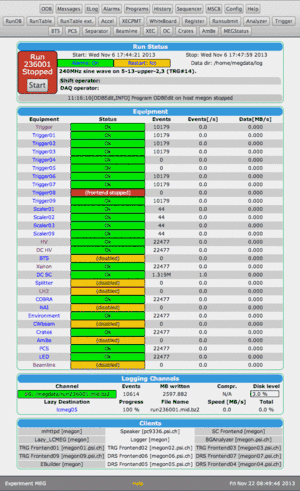Maximum Integrated Data Acquisition System
MIDAS is a DAQ package developed at the Paul Scherrer Institute, Switzerland, and TRIUMF, Canada. It was designed for particle detectors using CAMAC and VMEbus hardware.
 | |
 Example web page via mhttpd showing status of an experiment | |
| Developer(s) | Paul Scherrer Institute, TRIUMF |
|---|---|
| Stable release | 2.0.0
/ November 2, 2007 |
| Repository | |
| Operating system | Cross-platform |
| Type | Data acquisition |
| License | GPL |
| Website | midas |
Description
MIDAS (Maximum Integration Data Acquisition System) has been developed as a general purpose data acquisition system for small and medium scale experiments originally by Stefan Ritt in 1993, followed by Pierre-André Amaudruz in 1996. It is written in C and published under the GPL.
The experiment complexity ranges from test systems, where a single PC is connected to CAMAC via a PC-CAMAC interface, to experiments with several front-end computers and analysis nodes. The system currently runs under Linux, MS Windows, various versions of UNIX, VMS, VxWorks and MS-DOS and can be ported easily to virtually any operating system which supports TCP/IP sockets.
A speed optimized RPC layer is used for data exchange, with which sustained data rates of 980kB/s (10BaseT), 8.7 MB/s (100BaseT) and up to 98MB/s (1000BaseT). An integrated slow control system contains a fast online database and a history system. Drivers exist for CAMAC, VME, Fastbus, High Voltage Crates, GBIB and several PC plug-in DAQ boards. A framework is supplied which can be extended by user code for front-end readout on one side and data analysis on the other side. The online data can be presented by PAW as histograms and N-tuples as well as by ROOT. A dedicated HTTP server gives fast Web access for experiment control and to access the slow control system including a graphical representation of variable trends (history display).
Usage of MIDAS
MIDAS is used in many experiments in nuclear and particle physics. Following list shows a few of them: